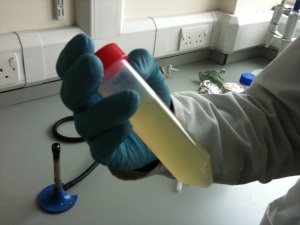Secrecy has long been a part of scientific and innovation practices. Being an ethnographer of laboratories, one occasionally comes up against a barrier of entry to a secret lab or space within a building, protected by intellectual property agreements, military or government contracts. Of course, military science is often conducted in secret, on nuclear, biological or chemical weapons, amongst other things. In his excellent book on ‘Secrecy and Science’, Brian Balmer describes how the Manhattan Project epitomised the way in which scientific secrecy operates at various levels of social organisation:
It was, in fact, an almost unprecedented organisation of not only scientists, but also industry and military. Moreover, a significant feature that accounts for the success of the Manhattan Project is the preoccupation with secrecy at the various sites involved in creating the atomic bomb. Compartmentalisation, telling people information on a strict need-to-know basis, meant only a few people had a complete overview of the project. […] In this manner, efficiency, security, bureaucracy and secrecy all came together at once. (Balmer, 2013: 8)

By their nature, it is often the most controversial, risky and ethically dubious research programmes that are conducted in secret, curtained-off from society in order to protect knowledge and technology not only from public scrutiny but also espionage or corporate theft. Thus when we find out that science has been conducted in secret we are generally right to be suspicious, and it should be no surprise that a meeting convened earlier this week, behind closed doors at Harvard, on the prospect of synthesising the human genome, has caused a stir.

The meeting was convened to discuss the prospects of coordinating a large collaborative venture to follow-up on the Human Genome Project (HGP), that would, over the next decade, seek to construct an entire human genome in a cell line. Currently unfunded but to be prospectively titled ‘HGP-Write: Testing Large Synthetic Genomes in Cells’, it is backed by some of the biggest names in the field.
As the New York Times reports the meeting was invite-only and “The nearly 150 attendees were told not to contact the news media or to post on Twitter during the meeting.” In this regard, it would seem that scientists hosting the meeting wanted for the event to be part of what we could conceptualise – following the sociologist, Georg Simmels’ well-known work on secrecy – as synthetic biology’s ‘second world’. As Simmel argued:
Secrecy secures, so to speak, the possibility of a second world alongside of the obvious world, and the latter is most strenuously affected by the former. Every relationship between two individuals or two groups will be characterized by the ratio of secrecy that is involved in it. Even when one of the parties does not notice the secret factor, yet the attitude of the concealer, and consequently the whole relationship, will be modified by it. (Simmel, 1906: 462)

A second world for synthetic biology is probably quite appealing to scientists working in the field, a space in which they could run-wild with their ideas without the worry of what a supposedly fearful public might think. Synthetic biologists, for the large part, expect the public will be inappropriately scared of developments in the field. This has led to what Claire Marris (2015) calls ‘synbiophobia phobia’ – the fear that scientists have that the public will fear their work.
Synbiophobia phobia might be at the root of the decision to hold the meeting in private, as the organisers likely anticipated public fear at the potential of creating a human genome from scratch. But, as Simmel’s notion reminds us, no matter whether parties kept in the dark find out about the secrets being kept or not, the effect of secrecy is to change the attitude of the concealer and consequently the whole relationship between scientists and civil society.
 Contrary to some scientist’s reactions to the media response to the closed meeting, secrecy in synthetic biology isn’t just a fiction created by newspapers and magazines to whip-up a story. The field does have at least the beginnings of a second world, divorced from public scrutiny, then it is almost certainly going to be tied to the Defense Advanced Research Projects Agency (DARPA), which has had a keen interest in the field since its fledgling years and has invested tens of millions into synthetic biology under the remit of the Biological Technologies Office.
Contrary to some scientist’s reactions to the media response to the closed meeting, secrecy in synthetic biology isn’t just a fiction created by newspapers and magazines to whip-up a story. The field does have at least the beginnings of a second world, divorced from public scrutiny, then it is almost certainly going to be tied to the Defense Advanced Research Projects Agency (DARPA), which has had a keen interest in the field since its fledgling years and has invested tens of millions into synthetic biology under the remit of the Biological Technologies Office.
However, speaking to the NYT, George Church, one of the most prominent advocates of synthetic biology and co-organiser of the Harvard meeting, argued that the event had been misconstrued and that the secrecy was actually about protecting a paper currently under review that, if published, would make the ideas for the project publicly-available and thus transparent. But as the invite read, “We intentionally did not invite the media, because we want everyone to speak freely and candidly without concerns about being misquoted or misinterpreted as the discussions evolve.” Whatever the motivation for the closed-doors, invite-only meeting, the effect of concealment might well be the same: it implies that something suspicious is going on.
In this regard, the scientists have shot themselves in the foot. The meeting will worry people, even those who support synthetic biology in general. In fact, one of the most well-known advocates for synthetic biology, Drew Endy, refused to attend and co-authored an open letter criticising the closed meeting. It is only a matter of time until those more critical voices and outright enemies of synthetic biology seize on the secrecy of the meeting as further evidence of untoward ambitions for the field. It would be a mistake, though, to see this as unwarranted fear and ignorance. It has much more to do with the facts of synthetic biology and how it is being developed in relation to corporate interests. As Endy and Zoloth’s (2016: 2) letter argued:
The creation of new human life is one of the last human-associated processes that has not yet been industrialized or fully commodified. It remains an act of faith, joy, and hope. Discussions to synthesize, for the first time, a human genome should not occur in closed rooms.
Two of the common tenets of the emerging frameworks for responsible research and innovation, which has been closely tied to the development of synthetic biology, are the importance of scientific transparency and of deliberative governance processes. The UK Synthetic Biology Roadmap, for example, includes a commitment that the Synthetic Biology Leadership Council should “should provide an exemplar of openness and transparency with two-way stakeholder engagement as a core principle.” (SBRCG, 2012: 32)

But transparency is easier invoked than it is implemented. If scientists are going to take responsible research and innovation seriously, then actually implementing transparency and deliberation is going to be crucial, especially when the choices about such things are immediately within their control, as was the case this week. A second world for synthetic biology might be appealing in principle, but in practice it risks bringing about exactly the kinds of public fears that scientists and engineers worry about.
References
Balmer, B. (2013) Secrecy and science: A historical sociology of biological and chemical warfare. Surrey: Ashgate.
Marris, C. (2015). The construction of imaginaries of the public as a threat to synthetic biology. Science as Culture, 24(1), 83-98.
Simmel, G. (1906) The sociology of secrecy and of secret societies. The American Journal of Sociology, 11(4), 441-498.
SBRCG (2012) A Synthetic Biology Roadmap for the UK, http://www.rcuk.ac.uk/RCUK-prod/assets/documents/publications/SyntheticBiologyRoadmap.pdf












